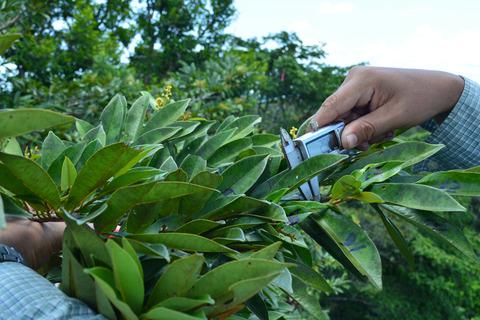当前位置:
X-MOL 学术
›
Funct. Ecol.
›
论文详情
Our official English website, www.x-mol.net, welcomes your
feedback! (Note: you will need to create a separate account there.)
Lianas explore the forest canopy more effectively than trees under drier conditions
Functional Ecology ( IF 4.6 ) Pub Date : 2020-11-11 , DOI: 10.1111/1365-2435.13717 José A. Medina‐Vega 1, 2 , Frans Bongers 1 , Stefan A. Schnitzer 2, 3 , Frank J. Sterck 1
中文翻译:

在干燥的条件下,藤本植物比树木更有效地探索林冠层
更新日期:2020-11-11
Functional Ecology ( IF 4.6 ) Pub Date : 2020-11-11 , DOI: 10.1111/1365-2435.13717 José A. Medina‐Vega 1, 2 , Frans Bongers 1 , Stefan A. Schnitzer 2, 3 , Frank J. Sterck 1
Affiliation

|
- Lianas rely on trees for support and access to high‐light positions in the forest canopy, but the implications for how lianas explore the canopy compared to trees remain understudied. We present an in situ forest canopy study to test the hypotheses that: (1) lianas favour leaf display over stem investment compared to trees and (2) lianas have greater potential to colonize non‐shaded, high‐light areas effectively than trees.
- We compared branches of 16 liana species with those of 16 sympatric tree species in the canopy of two lowland tropical forests with contrasting rainfall regimes in Panama using 40–50 m tall canopy cranes. One forest was relatively dry and seasonal in rainfall and associated solar radiation. The other forest was relatively wet and had a weaker seasonality.
- We observed that lianas were more efficient in leaf display over stem investment than trees, particularly in the forest with lower precipitation and stronger seasonality. Specifically, lianas had a lower LMA (leaf mass per unit leaf area), stronger apical dominance, higher stem slenderness and fewer leaf layers than trees. In the forest with higher precipitation and weaker seasonality, lianas also had stronger apical control and fewer leaf layers than trees, but both lianas and trees were relatively similar in LMA and stem slenderness.
- Our study shows that lianas more effectively explore the canopy than trees under drier conditions, but much less so under wetter conditions. We argue that lianas display a functional strategy that allows them to better intercept light than the tree species in forests with low precipitation and strong seasonality, while they are constrained to display such strategy at high precipitation – light‐limited – sites.
中文翻译:

在干燥的条件下,藤本植物比树木更有效地探索林冠层
- 藤本植物依靠树木作为支撑和进入森林冠层的高光位置,但是与树木相比,藤本植物如何探索树冠的含义仍未得到研究。我们提出了一个原地森林冠层研究,以验证以下假设:(1)与树木相比,藤本植物更喜欢叶片展示而不是茎干投资;(2)藤本植物比树木更有效地定居非遮蔽,高光区域。
- 我们比较了两个低地热带森林林冠中16种藤本植物的分支与16种同属植物树的分支,并使用40–50 m高的树冠起重机比较了巴拿马的降雨情况。一个森林的降雨和相关的太阳辐射相对干燥和季节性。另一个森林相对湿润,季节性较弱。
- 我们观察到藤本植物在茎干投资方面的叶片展示比树木更有效,尤其是在降水量较低且季节性更强的森林中。具体而言,藤本植物的LMA(单位叶面积的叶质量)较低,顶端优势更强,茎细长且叶层数少于树木。在降水较高,季节较弱的森林中,藤本植物的顶端控制也比树木要少,但藤本植物和树木在LMA和茎细长方面相对相似。
- 我们的研究表明,在干燥的条件下,藤本植物比树木更有效地探索树冠,而在潮湿的条件下,树冠探索树冠的效率要低得多。我们认为藤本植物显示出一种功能性策略,该方法可以使它们比低降水量和季节性强的森林中的树种更好地拦截光,而它们被限制在高降水量(光线有限)的地点显示这种策略。











































 京公网安备 11010802027423号
京公网安备 11010802027423号